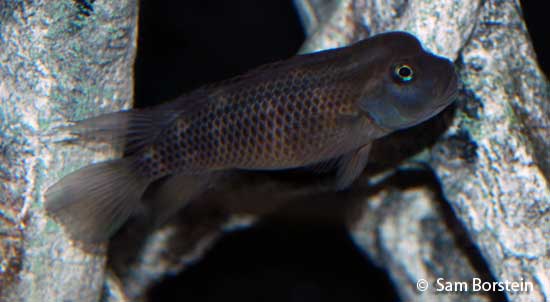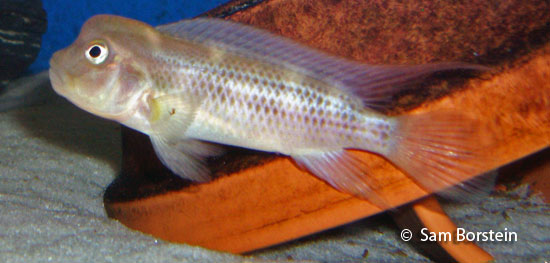Steatocranus casuarius
Poll, 1939
Buffalo Head Cichlid

Above: A female Buffalo head. Photo by Sam Borstein.
Etymology:
Genus- Steato=fat (Greek), cranus= skull (Greek). Referring to the large heads of the fish.
Species- casuarius= from cassis meaning helmet (Latin).
Intro:
Steatocranus casuarius, also known as the Buffalo Head is a West African Cichlid that is dear to many hobbyists' hearts. This fish gets its common name from the large hump on the males heads. This little, pugnacious fish was first typed by Poll in 1939. They are rheophilic, and therefore have a reduced swim bladder. Steatocranus stay near the bottom of the tank, spending their time scooting around in a very entertaining fashion.
Distribution:
Steatocranus casuarius is found in the wild in the fast flowing water of the lower and middle regions of the Congo River. This fish is found in abundance at a particular location point, Stanley Pool . Specimens do not differ appreciatively when taken from various location points (Lamboj, 2004).
Size, Maturity, and Sexual Dimorphism:
Size: Males- 5 inches, Females- 4.5 inches
Maturity: 2 inches
Sexual Dimorphism: Males are larger and have much longer fins than the females. Females tend to have a rounder body shape. Males also develop a larger hump.
Care:
Buffalo Heads are easy to care for. Despite the fact that this diminutive fish is pair bonding and can be kept in a 20 gallon tank, I advise placing the fish in a larger community tank with either docile Pseuodotropheus, or other West Africans. This way the fish are more active and enjoyable. I think it also keeps the pair bond strong. Buffalo Heads also mix quite well with Victorian cichlids as well as West African tetras and barbs.
The tank should be about 76-80F degrees and offer good water movement. Furnish the tank with caves and rocks. They can handle a large range of water parameters. Mine thrived in Chicago tap water, which is around 7.4-7.6 pH.

Above: A young male Buffalo Head. Photo by Sam Borstein
Diet:
Buffalo Heads mostly eat algae in the wild. I fed a variety of foods such as fish Dainichi Veggie Deluxe, various flakes, and New Life Spectrum. The fish are not picky.
Breeding:
My Buffalo Heads were wild and were about 2-2.5 inches. I put them in a sixty gallon tank with some gentle Pseudotropheus and some Kribensis types. Immediately the pair showed breeding behavior and shortly thereafter, spawned.
Before spawning, the female will take on a round, nearly bloated appearance and will get a hump, sometimes as large as the male.
The fish laid only thirty eggs in a clay cave, but the eggs were huge! The largest eggs I have ever seen from a West African cichlid.
The eggs took forever to hatch. I checked the water temperature and it was at 78F degrees, so I knew that temperature was not the cause of the slow development. I finally accepted the fact that the larger the eggs, the longer they take to hatch. Indeed, after hearing some other fishkeepers experiences, it seemed typical. After six days, the eggs finally hatched and were free swimming six days hence.
The fry were very large— about half an inch, and eagerly accepted newly hatched baby brine shrimp. The parents fiercely defended the fry and owned about two-thirds of a three foot tank. After about a week, the fry were an inch long. They are easy to raise and extremely cute in appearance looking just like their parents, scooting around the bottom of the tank.
Conclusion:
If you are just getting into West Africans, this is a good starting fish. The fish lack in color, but they are peaceful, easy to keep, and display unique behavior. You will occasionally find this fish at pet shops, but you most likely will have to find a local breeder if you want these guys. The fish will usually run you about $5 for juveniles and pairs are anywhere from $20-$30.
References:
- Lamboj, A. (2004). The Cichlid Fishes of Western Africa. Bergit Schmettkamp Verlag, Bornheim, Germany, 255 pp.
